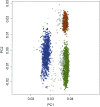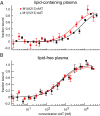Common coding variant in SERPINA1 increases the risk for large artery stroke
- PMID: 28265093
- PMCID: PMC5389268
- DOI: 10.1073/pnas.1616301114
Common coding variant in SERPINA1 increases the risk for large artery stroke
Abstract
Large artery atherosclerotic stroke (LAS) shows substantial heritability not explained by previous genome-wide association studies. Here, we explore the role of coding variation in LAS by analyzing variants on the HumanExome BeadChip in a total of 3,127 cases and 9,778 controls from Europe, Australia, and South Asia. We report on a nonsynonymous single-nucleotide variant in serpin family A member 1 (SERPINA1) encoding alpha-1 antitrypsin [AAT; p.V213A; P = 5.99E-9, odds ratio (OR) = 1.22] and confirm histone deacetylase 9 (HDAC9) as a major risk gene for LAS with an association in the 3'-UTR (rs2023938; P = 7.76E-7, OR = 1.28). Using quantitative microscale thermophoresis, we show that M1 (A213) exhibits an almost twofold lower dissociation constant with its primary target human neutrophil elastase (NE) in lipoprotein-containing plasma, but not in lipid-free plasma. Hydrogen/deuterium exchange combined with mass spectrometry further revealed a significant difference in the global flexibility of the two variants. The observed stronger interaction with lipoproteins in plasma and reduced global flexibility of the Val-213 variant most likely improve its local availability and reduce the extent of proteolytic inactivation by other proteases in atherosclerotic plaques. Our results indicate that the interplay between AAT, NE, and lipoprotein particles is modulated by the gate region around position 213 in AAT, far away from the unaltered reactive center loop (357-360). Collectively, our findings point to a functionally relevant balance between lipoproteins, proteases, and AAT in atherosclerosis.
Keywords: antitrypsin; genetics; ischemic stroke; large artery stroke; variation.
Conflict of interest statement
The authors declare no conflict of interest.
Figures






Comment in
-
Alpha-1 antitrypsin dysfunction and large artery stroke.Proc Natl Acad Sci U S A. 2017 Apr 4;114(14):3555-3557. doi: 10.1073/pnas.1702751114. Epub 2017 Mar 27. Proc Natl Acad Sci U S A. 2017. PMID: 28348245 Free PMC article. No abstract available.
References
-
- Mozaffarian D, et al. American Heart Association Statistics Committee and Stroke Statistics Subcommittee Heart disease and stroke statistics--2015 update: A report from the American Heart Association. Circulation. 2015;131(4):e29–e322. - PubMed
-
- WHO 2014 The top 10 causes of death. Available at www.who.int/mediacentre/factsheets/fs310/en/. Accessed December 7, 2015.
-
- Schneider AT, et al. Ischemic stroke subtypes: A population-based study of incidence rates among blacks and whites. Stroke. 2004;35(7):1552–1556. - PubMed
-
- Traylor M, et al. Australian Stroke Genetics Collaborative; Wellcome Trust Case Control Consortium 2 (WTCCC2); International Stroke Genetics Consortium Genetic risk factors for ischaemic stroke and its subtypes (the METASTROKE collaboration): A meta-analysis of genome-wide association studies. Lancet Neurol. 2012;11(11):951–962. - PMC - PubMed
-
- Weber C, Noels H. Atherosclerosis: Current pathogenesis and therapeutic options. Nat Med. 2011;17(11):1410–1422. - PubMed
Publication types
MeSH terms
Substances
Grants and funding
LinkOut - more resources
Full Text Sources
Other Literature Sources
Medical
Research Materials
Miscellaneous

